Constant advances in neuroimaging technology have enabled the detection of abnormal brain structures that can cause epilepsy or neurodevelopmental impairment and have provided opportunities for epilepsy surgery by providing high-quality information about the brains of patients with pediatric epilepsy [1,2]. Advanced neuroimaging using multimodal procedures is an important diagnostic tool for identifying biomarkers of epileptogenesis and drug-resistant epilepsy. Magnetic resonance imaging (MRI) identifies structural and functional changes in abnormal neuropathologic areas with postprocessing and advanced techniques. Positron emission tomography (PET) and single-photon emission computerized tomography (SPECT) provide the information for cerebral functional changes of epileptogenic areas via brain metabolism and blood perfusion [3]. Multimodal techniques such as PET-MRI, subtraction of interictal from ictal SPECT coregistered to MRI (SISCOM), electroencephalography-functional MRI (EEG-fMRI), and magnetoencephalography (MEG) can also help elucidate the functional alterations of epileptogenic areas in epilepsy [4].
When the first unprovoked seizure occurs or newly diagnosed epilepsy is confirmed, MRI should immediately be performed because structural lesion strongly indicates drug resistance in epilepsy. The International League Against Epilepsy recently provided a new consensus recommendation for the use of MRI in epilepsy. The Neuroimaging Task Force recommendation suggests the use of Harmonized Neuroimaging of Epilepsy Strucural Sequences (HARNESS-MRI) to better identify the structural lesions that may be in the epileptogenic region. HARNESS-MRI reveals high-resolution 3-dimensional (3D) T1-weighted imaging with isotropic millimetric voxel resolution (1 mm×1 mm×1 mm) and no interslice gap, high-resolution 3D fluid attenuation inversion recovery (FLAIR) with isotropic millimetric voxel resolution (1 mm×1 mm×1 mm) and no interslice gap, and high in-plane resolution 2-dimensional coronal T2-weighted imaging with submillimetric voxel resolution (0.4 mm×0.4 mm×2 mm perpendicular to the long axis of the hippocampus) and no interslice gap [1]. In patients younger than 2 years of age, it is important to consider that MRI sequences should differ due to poor myelination that appears at this time [2]. The early detection on MRI is important in pediatric epilepsy, and repeated MRI should be recommended due to ongoing myelination, particularly when patients have no structural lesions [5]. MRI using the HARNESS-MRI protocol should also be repeated when an unexplained increase in seizure frequency, rapid deterioration in cognition and development, or the appearance/exacerbation of neuropsychiatric symptoms occurs [1]. To better detect epileptogenic areas, MRI postprocessing can be applied, with which several studies reported higher positive detection rates of epileptogenic areas [6,7]. However, it is essential to have standards with reproducibility and clinical validation.
In children with drug-resistant focal epilepsy, epilepsy surgery is an acceptable treatment; for this purpose, epileptogenic areas should be detected as precisely as possible. For epilepsy surgery, interictal/ictal EEG, video EEG, MRI, fluorodeoxyglucose (FDG)-PET, SPECT, electrocorticography, and intracranial monitoring are among the mandatory diagnostic tests used to localize epileptogenic areas [4]. FDG-PET reveals a wider hypometabolism than the epileptogenic areas, possibly indicative of functional abnormalities. Ictal/interictal SPECT reveals focal hyperperfusion/hypoperfusion of epileptogenic areas and is more suitable than PET in that aspect. Advanced neuroimaging techniques with the potential ability to detect epileptogenic areas include PET-MRI, SISCOM, EEG-fMRI, EEG source imaging, MEG, MR spectroscopy, MRI postprocessing techniques, and diffusionweighted imaging with tractography [5]. EEG source imaging/MEG helps localize epileptogenic areas as well as those with altered functional connectivity. EEG records tangential and radial currents with temporal resolution but has limited spatial resolution. EEG source imaging overcomes the limitations of EEG recordings in terms of temporal and spatial resolution. MEG records magnetic fields of tangential currents, which can be used for MRI-negative patients with suspected tangential areas in which the EEG tracing is likely to be distorted. In terms of cost effectiveness, EEG source imaging may be superior to MEG, but the EEG source imaging and MEG are complementary. MEG and fMRI can effectively detect eloquent areas in children and young children, in whom clinical assessments may be difficult and very few validation studies are available [8].
Advanced neuroimaging is a challenging tool in the field of pediatric epilepsy. It is now possible to identify the epileptogenic areas in nonlesional cases and increase surgical candidates. Advanced neuroimaging can be a prognostic factor for better surgical outcomes that can replace invasive tests and provide information about the eloquent areas, reducing functional deficits that may arise due to excision of the eloquent areas. Advanced neuroimaging will be an important diagnostic tool for identifying biomarkers of epileptogenesis, altered functional connectivity, and localization of epileptogenic areas.





 PDF Links
PDF Links PubReader
PubReader ePub Link
ePub Link PubMed
PubMed Download Citation
Download Citation


